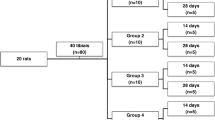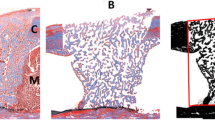Abstract
The aim of this study was to investigate the effects of alendronate (Aln) irrigation with low-level laser therapy (LLLT) on the healing of bone defects in rats. Sixty Wistar rats weighing 250 to 300 g were randomly divided into three groups of 20 animals each: (1) control group, (2) Aln group, and (3) Aln with LLLT group. The distal epiphysis of all rats was perforated with a surgical bone drill. Twenty rats served as control. The bone defects of 40 rats received local alendronate sodium trihydrate irrigation (1 mg/ml) at the time of surgery. LLLT was applied to the bone defects of 20 rats immediately after Aln irrigation, and repeated on days 2, 4, 6, and 8 with a total dose of 10 J/cm2 (2 J/cm2 × 5). Continuous wave of GaAlAs laser (808 nm) was used with a power density of 0.1 W/cm2. Laser energy was applied for 20 s (0.1 W × 20 s/1 cm2) per session. Control group, Aln group, and Aln with LLLT group rats were sacrificed at days 10 and 20 to compare the bone healing of each group histologically. There were significant differences between the three groups regarding union, substantia spongiosa, cortex formation, and in sum of histologic scores on days 10 and 20 (P < 0.0001). Our findings demonstrated that Aln has a more positive effect with LLLT on bone healing in rats. It was concluded that combining LLLT (808 nm laser at 10 J/cm2) with Aln irrigation has a beneficial effect in bone repair. It was demonstrated experimentally that Aln irrigation during the surgery had a significant effect to enhance bone formation, and LLLT significantly potentiated the osseous healing effects of Aln on bone defects. This administration method is able to minimize the dose of Aln in order to avoid both systemic and local adverse effects as well as the local injection times during the bone healing process.




Similar content being viewed by others
References
Gupta A, Dai T, Hamblin MR (2014) Effect of red and near-infrared wavelengths on low-level laser (light) therapy-induced healing of partial-thickness dermal abrasion in mice. Lasers Med Sci 29(1):257–265
Ueda Y, Shimizu N (2003) Effects of pulse frequency of low-level laser therapy (LLLT) on bone nodule formation in rat calvarial cells. J Clin Laser Med Surg 21:271–277
Dortbudak O, Haas R, Mailath-Pokorny G (2002) Effect of low power laser irradiation on bony implant sites. Clin Oral Implants Res 13:288–292
Akyol UK, Güngörmüş M (2010) Effect of biostimulation on healing of bone defects in diabetic rats. Photomed Laser Surg 28(3):411–416
Kashii M, Hashimoto J, Nakano T, Umakoshi Y, Yoshikawa H (2008) Alendronate treatment promotes bone formation with a less anisotropic microstructure during intramembranous ossification in rats. J Bone Miner Metab 26(1):24–33
von Knoch F, Jaquiery C, Kowalsky M, Schaeren S et al (2005) Effects of bisphosphonates on proliferation and osteoblast differentiation of human bone marrow stromal cells. Biomaterials 26(34):6941–6949
Russell RG, Watts NB, Ebetino FH, Rogers MJ (2008) Mechanisms of action of bisphosphonates: similarities and differences and their potential influence on clinical efficacy. Osteoporos Int 19(6):733–759
Lindsay R, Watts NB, Lange JL, Delmas PD, Silverman SL (2013) Effectiveness of risedronate and alendronate on nonvertebral fractures: an observational study through 2 years of therapy. Osteoporos Int Aug 24(8):2345–2352
Tekin U, Tuz HH, Onder E, Ozkaynak O, Korkusuz P (2008) Effects of alendronate on rate of distraction in rabbit mandibles. J Oral Maxillofac Surg 66:2042–2049
Yoshioka T, Okimoto N, Okamoto K, Sakai A (2013) A comparative study of the effects of daily minodronate and weekly alendronate on upper gastrointestinal symptoms, bone resorption, and back pain in postmenopausal osteoporosis patients. J Bone Miner Metab 31(2):153–160
Marini JC (2003) Do bisphosphonates make children’s bones better or brittle? N Engl J Med 349:423–426
Lin JH (1996) Bisphosphonates: a review of their pharmacokinetic properties. Bone 18(2):75–85
Omi H, Kusumi T, Kijima H, Toh S (2007) Locally administered low-dose alendronate increases bone mineral density during distraction osteogenesis in a rabbit model. J Bone Joint Surg Br 89(7):984–988
Heiple KG, Goldberg VM, Powell AE et al (1987) Biology of cancellous bone grafts. Orthop Clin North Am 18:179–185
Coxon FP, Thompson K, Roelofs AJ, Ebetino FH, Rogers MJ (2008) Visualizing mineral binding and uptake of bisphosphonate by osteoclasts and non-resorbing cells. Bone 42:848–860
Leu CT, Luegmayr E, Freedman LP, Rodan GA, Reszka AA (2006) Relative binding affinities of bisphosphonates for human bone and relationship to antiresorptive efficacy. Bone 38:628–636
da Silva RV, Camilli JA (2006) Repair of bone defects treated with autogenous bone graft and low-power laser. J Craniofac Surg 17:297–301
Abbaspour A, Takahashi M, Sairyo K, Takata S, Yukata K, Inui A, Yasui N (2009) Optimal increase in bone mass by continuous local infusion of alendronate during distraction osteogenesis in rabbits. Bone 44(5):917–923
Baiomy AA, Nassan MA, Abdellatif EM, Abdel Fattah A, El-Fekey AA, Abdel Aal AB (2012) Experimental comparison of the effects of locally administered zoledronic acid and alendronate on the rate of mandibular distraction osteogenesis in dogs. Oral Surg Oral Med Oral Pathol Oral Radiol 118(1):35–42
Jakobsen T, Baas J, Bechtold JE, Elmeengard B, Soballe K (2007) Soaking morselized allograft in bisphosphonate can impair implant fixation. Clin Orthop Relat Res 463:195–201
Still K, Phipps RJ, Scutt A (2003) Effects of risedronate, alendronate, and etidronate on the viability and activity of rat bone marrow stromal cells in vitro. Calcif Tissue Int 72:143–150
Ziebart T, Ziebart J, Gauss L, Pabst A, Ackermann M, Smeets R, Konerding MA, Walter C (2013) Investigation of inhibitory effects on EPC mediated neovascularization by different bisphosphonates for cancer therapy. Biomed Rep 1(5):719–722
Barbosa D, de Souza RA, Xavier M, da Silva FF, Arisawa EA, Villaverde AG (2013) Effects of low-level laser therapy (LLLT) on bone repair in rats: optical densitometry analysis. Lasers Med Sci 28(2):651–656
Garcia VG, da Conceição JM, Fernandes LA, de Almeida JM, Nagata MJ, Bosco AF, Theodoro LH (2013) Effects of LLLT in combination with bisphosphonate on bone healing in critical size defects: a histological and histometric study in rat calvaria. Lasers Med Sci 28(2):407–414
Khadra M, Kasem N, Haanaes HR, Ellingsen JE, Lyngstadaas SP (2004) Enhancement of bone formation in rat calvarial bone defects using low-level laser therapy. Oral Surg Oral Med Oral Pathol Oral Radiol Endod 97:693–700
Akyol U, Güngörmüş M (2010) The effect of low-level laser therapy on healing of skin incisions made using a diode laser in diabetic rats. Photomed Laser Surg 28(1):51–55
Conflict of interest
The authors have no conflict of interest with this manuscript. The study was conducted according to the guidelines of Ataturk University Faculty of Veterinary Animal Care and Use Ethic Committee.
Author information
Authors and Affiliations
Corresponding author
Rights and permissions
About this article
Cite this article
Akyol, U.K., Sipal, S., Demirci, E. et al. The influence of low-level laser therapy with alendronate irrigation on healing of bone defects in rats. Lasers Med Sci 30, 1141–1146 (2015). https://doi.org/10.1007/s10103-015-1720-y
Received:
Accepted:
Published:
Issue Date:
DOI: https://doi.org/10.1007/s10103-015-1720-y




